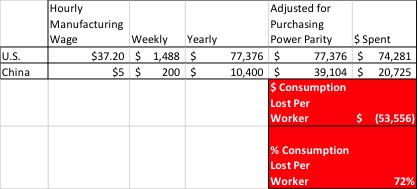Chinese consumers aren’t buying their fair share

Treasury Secretary Steve Mnuchin and the U.S. delegation had their work cut out for them in China last week. In the first quarter, China exported nearly four times as many goods to the U.S. as the U.S. exported to China.

Source: U.S. Census Bureau
There are obvious causes behind this disparity, including:
- China’s massive levels of production and resulting global supply gluts;
- average tariffs nearly three times that of the U.S. (10 percent versus 3.4 percent for the U.S.);
- forced requirements to produce locally in return for market access; and
- a myriad of additional trade measures meant to help Chinese companies and limit U.S. companies.
{mosads}But there is an equally important issue that is not getting as much press but should be: China’s low rate of consumption. Not only is China flooding global markets with non-economic exports while limiting access to its market, it is consuming far less on average than most other countries in the world.
According to the Organization for Economic Cooperation and Development (OECD), while U.S. consumers spend about $0.97 of every dollar, Chinese consumers only spend $0.53 of every dollar. Put another way, U.S. consumers save around 3-4 percent on average, while China’s consumers save 47 percent.
For a broader perspective, the average country tracked by the OECD spent more than $0.92 of every dollar, much more than the $0.53 spent by China’s consumers. Clearly, China’s disproportionately low consumption rate makes it difficult for the U.S. to have an equal trade balance in goods.
Exacerbating this imbalance in spending is the much lower income earned by Chinese workers. Not only do Chinese workers spend less, they make less, resulting in less purchasing power.
Economists often talk of the growing Chinese middle class and the goods they purchase as an offset when U.S. jobs are shipped to China. What they fail to mention is the reduction in consumption per worker when U.S. jobs are shipped to China.
While the average U.S. manufacturing employee earned more than $37 per hour, no region of China had an average manufacturing wage of $5 per hour.
Even generously assuming $5 per hour and accounting for purchasing power parity, on average, each U.S. manufacturing job sent to China results in a more than $53,000 reduction in purchasing power, a 72 percent decline.
While China’s middle class may be growing, its workers just don’t have as much spending power, and they spend less of what they earn, contributing to the massive trade imbalance in goods with China.

Source: Solutionomics using Economist Business Intelligence Unit and OECD data
China’s aggressive production activities, conservative spending and lower wages are a problem not just for the U.S. but the world.
China has a significant global imbalance in its goods exports and imports. In 2017, China exported 27.4 percent more than it imported. China was a net detractor from global consumption in relation to how much it sells to the world.

Source: OECD
Conversely, the U.S. imported 34 percent more than it exported. The U.S. was a net-positive contributor to global consumption in relation to how much it sells the world.

Source: OECD

While quotas, tariffs, forced technology transfers and mandating U.S. companies partner with Chinese companies contribute to the U.S. goods deficit with China and have gotten all the headlines, conservative spending on the part of China’s consumers is a major source of the trade in goods deficit.
While Secretary Mnuchin is correct to work on gaining greater access to China’s market, access is only one part of the problem. China’s limited willingness to contribute to global demand at rates equal to the rest of the world must also be addressed.
Chris Macke is the founder of Solutionomics, a think tank focused on developing solutions and recommendations for a more efficient, merit-based corporate tax code. He has advised the U.S. Federal Reserve by providing market updates and implications of monetary policy changes on asset valuations and market distortions, and he’s a contributor to the Fed Beige Book. Find him on Twitter: @solutionomics.
Copyright 2023 Nexstar Media Inc. All rights reserved. This material may not be published, broadcast, rewritten, or redistributed. Regular the hill posts







